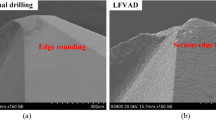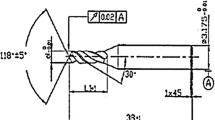Abstract
Hole machining of nickel-based alloys has a wide application space in aerospace manufacturing industry, but the high cutting force, high cutting temperature, large plastic deformation, cold work hardening and severe tool wear during the cutting process of nickel-based alloys make them typical difficult-to-machine materials. Therefore, when drilling nickel-based alloys, the selection of cutting parameters is very important. Reasonable cutting parameters will help to control the chip shape and facilitate chip removal. In this paper, the cutting force, cutting temperature, and tool life of high-speed steels in drilling Nickel-based superalloy Inconel 718 was investigated through orthogonal cutting experiments. Then the empirical method of multi-factor line regression was used to establish the empirical models of drilling torque, thrust force, cutting temperature, and tool life of the drills with emulsion as the cutting fluid, and to verify the validity of the established model, and the significance of the regression method is tested to verify the effectiveness of the model. The tool wear morphology and wear mechanisms were examined by scanning electron microscope (SEM) and energy spectrum analysis (EDS). The results revealed that the major drill wear modes incorporate flank wear, peripheral wear, micro-chipping and chipping, and the tool failure mechanisms were comprehensively synergistic interactions among abrasive wear, adhesive wear, and oxidation wear. In addition, the cutting parameters of high-speed steels in drilling Nickel-based superalloy were optimized based on the response surface methodology of equivalent tool life-efficiency, and then the reasonable cutting parameters under the condition of using cutting fluid were recommended.












Similar content being viewed by others
References
Zheng WH (2008) Machining technology of difficult cutting materials. National Defense Industry Press, Beijing, pp 147–168
Sharman ARC, Amarasinghe A, Ridgway K (2008) Tool life and surface integrity aspects when drilling and hole making in Inconel 718. J Mater Process Technol 200(1–3):424–432. https://doi.org/10.1016/j.jmatprotec.2007.08.080
Chen YC, Liao YS (2003) Study on wear mechanisms in drilling of Inconel 718 superalloy. J Mater Process Technol 140(1–3):269–273. https://doi.org/10.1016/S0924-0136(03)00792-1
Rahim EA, Sasahara H (2009) Application of minimum quantity lubrication when drilling nickel-based superalloy at high cutting speed. Key Eng Mater 407–408:612–615. https://doi.org/10.4028/www.scientific.net/KEM.407-408.612
Biermann D, Kirschner M (2015) Experimental investigations on single-lip deep hole drilling of superalloy Inconel 718 with small diameters. J Manuf Process 20:332–339. https://doi.org/10.1016/j.jmapro.2015.06.001
Uçak N, Çiçek A (2018) The effects of cutting conditions on cutting temperature and hole quality in drilling of Inconel 718 using solid carbide drills. J Manuf Process 31:662–673. https://doi.org/10.1016/j.jmapro.2018.01.003
Liu T, Li A, Zhu C, Yuan W (2022) Effect of alloying elements on surface temperature field of aluminum piston in diesel engine. Eng Fail Anal 134(3):106020. https://doi.org/10.1016/j.engfailanal.2021.106020
Bounif K, Abbadi M, Nouari M, Selvam R (2021) A numerical approach for crack-induced damage in tungsten carbide cutting tools during machining. Eng Fail Anal 128:105617. https://doi.org/10.1016/j.engfailanal.2021.105617
Thakur DG, Ramamoorthy B, Vijayaraghavan L (2009) Study on the machinability characteristics of superalloy Inconel 718 during high speed turning. Mater Design 30(5):1718–1725. https://doi.org/10.1016/j.matdes.2008.07.011
Kumar AS, Durai AR, Sornakumar T (2006) Wear behaviour of alumina based ceramic cutting tools on machining steels. Tribol Int 39(3):191–197. https://doi.org/10.1016/j.triboint.2005.01.021
Khanna N, Agrawal C, Gupta MK, Song Q (2020) Tool wear and hole quality evaluation in cryogenic drilling of Inconel 718 superalloy. Tribol Int 143:106084. https://doi.org/10.1016/j.triboint.2019.106084
Liang X, Liu Z (2018) Tool wear behaviors and corresponding machined surface topography during high-speed machining of Ti-6Al-4V with fine grain tools. Tribol Int 121:321–332. https://doi.org/10.1016/j.triboint.2018.01.057
Li C, Xu X, Li Y, Tong H, Ding S, Kong Q, Zhao L, Ding J (2019) Effects of dielectric fluids on surface integrity for the recast layer in high speed EDM drilling of nickel alloy. J Alloys Comp 783:95–102. https://doi.org/10.1016/j.jallcom.2018.12.283
Pang K, Wang D (2020) Study on the performances of the drilling process of nickel-based superalloy Inconel 718 with differently micro-textured drilling tools. Int J Mech Sci 180:105658. https://doi.org/10.1016/j.ijmecsci.2020.105658
Sales WF, Schoop J, Jawahir IS (2017) Tribological behavior of PCD tools during superfinishing turning of the Ti6Al4V alloy using cryogenic, hybrid and flood as lubri-coolant environments. Tribol Int 114:109–120. https://doi.org/10.1016/j.triboint.2017.03.038
Zhang Y, Li C, Ji H, Yang X, Yang M, Jia D, Zhang X, Li R, Wang J (2017) Analysis of grinding mechanics and improved predictive force model based on material-removal and plastic-stacking mechanisms. Int J Mach Tools Manuf 122:81–97. https://doi.org/10.1016/j.ijmachtools.2017.06.002
Chi Y, Dai W, Lu Z, Wang M, Zhao Y (2018) Real-time estimation for cutting tool wear based on modal analysis of monitored signals. Appl Sci 8(5):708. https://doi.org/10.3390/app8050708
Hao ZP, Lu Y, Gao D, Fan YH, Chang YL (2012) Cutting parameter optimization based on optimal cutting temperature in machining Inconel718. Mater Manuf Processes 27(10):1084–1089. https://doi.org/10.1080/10426914.2012.689456
Thrinadh J, Mohapatra A, Datta S, Masanta M (2020) Machining behavior of Inconel 718 superalloy: Effects of cutting speed and depth of cut. Mater Today Proc 26(Pt 2):200–208. https://doi.org/10.1016/j.matpr.2019.10.128
Osmond L, Curtis D, Slatter T (2021) Chip formation and wear mechanisms of SiAlON and whisker-reinforced ceramics when turning Inconel 718. Wear 486–487:204128. https://doi.org/10.1016/j.wear.2021.204128
Hou G, Li A (2021) Effect of surface micro-hardness change in multi-step machining on friction and wear characteristics of titanium alloy. Appl Sci 11(16):7471. https://doi.org/10.3390/app11167471
Funding
The authors would like to acknowledge the financial supports of the Natural Science Foundation of Shandong Province (ZR2021ME043), the Key Research and Development Program of Shandong Province (2019JZZY010114), the National Natural Science Foundation of China (51605260), and the Young Scholars Program of Shandong University (2018WLJH57).
Author information
Authors and Affiliations
Corresponding author
Ethics declarations
Declaration of Competing Interest
The authors declare that they have no known competing financial interests or personal relationships that could have appeared to influence the work reported in this paper.
Additional information
Publisher's Note
Springer Nature remains neutral with regard to jurisdictional claims in published maps and institutional affiliations.
Rights and permissions
About this article
Cite this article
Liu, J., Li, A., Zhang, J. et al. Performance of High-Speed Steel Drills in Wet Drilling Inconel 718 Superalloy. Exp Tech 47, 395–406 (2023). https://doi.org/10.1007/s40799-022-00560-x
Received:
Accepted:
Published:
Issue Date:
DOI: https://doi.org/10.1007/s40799-022-00560-x




